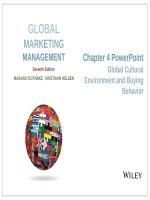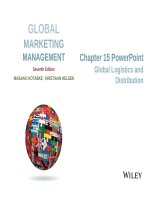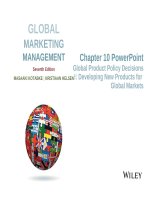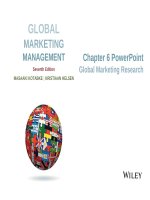Lecture Global marketing management (7th edition): Chapter 2 - Masaaki Kotabe, Kristiaan Helsen
Bạn đang xem bản rút gọn của tài liệu. Xem và tải ngay bản đầy đủ của tài liệu tại đây (3.93 MB, 34 trang )
GLOBAL
MARKETING
MANAGEMENT
Seventh Edition
Chapter 2 PowerPoint
Economic Environment
MASAAKI KOTABKE | KRISTIAAN HELSEN
Chapter 2
Copyright © 2017 John Wiley & Sons,
Inc.
1
Chapter Overview
1. Intertwined World Economy
2. Country Competitiveness
3. Emerging Economies
4. Evolution of Cooperative Global Trade Agreements
5. Information Technology and the Changing Nature
of Competition
6. Regional Economic Arrangements
7. Multinational Corporations
Chapter 2
Copyright © 2017 John Wiley & Sons,
Inc.
2
Introduction
In 2008, the annual global merchandise trade
amounted to $16.3 trillion.
From 1997 to 2007, world GDP grew more than 30
percent.
In the same period, total world exports of
merchandise increased by more than 60 percent.
The World Bank (at the time of this writing) predicted
that the global GDP growth would grow 2.9 percent
in 2016 and strengthen to 3.1 percent in 2017-18.
Chapter 2
Copyright © 2017 John Wiley & Sons,
Inc.
3
Exhibit 2-1: Growth in the Volume of World
Merchandise Trade and GDP, 2007-2014
Chapter 2
Copyright © 2017 John Wiley & Sons,
Inc.
4
Introduction
According to the World Trade Organization (WTO), the
top five merchandise exporting countries in 2014
were:
China ($2,343 billion)
The United States ($1,610 billion)
Germany ($1,547 billion)
Japan ($710 billion)
France ($583 billion)
Chapter 2
Copyright © 2017 John Wiley & Sons,
Inc.
5
Introduction
• Collectively, the top nine export nations accounted
for nearly half of world merchandise trade in 2014.
• The Triad Regions (North America, Western
Europe, and Japan) of the world collectively
produced nearly 60 percent of world GDP in 2007,
down from 78 percent in 2004.
Chapter 2
Copyright © 2017 John Wiley & Sons,
Inc.
6
Introduction
• The net result of these factors?
– Increased interdependence of countries/economies
– Increased competitiveness
– Need for firms to keep a constant watch on the
international economic environment.
• Consumers and companies in the U.S. and Japan
are able to find domestic sources for their needs
because of their diversified and extremely large
economies.
Chapter 2
Copyright © 2017 John Wiley & Sons,
Inc.
7
1. Intertwined World Economy
• Despite the increasingly intertwined world economy,
the United States is still relatively more insulated
from the global economy than other nations. In
2014, the U.S. economy was about $17.4 trillion and
about 13.4 percent of what Americans consumed
was imported in the United States.
Chapter 2
Copyright © 2017 John Wiley & Sons,
Inc.
8
Exhibit 2-2: Top 10 Exporters and Importers
in World Merchandise Trade, 2014
Chapter 2
Copyright © 2017 John Wiley & Sons,
Inc.
9
1. Intertwined World Economy
• The larger the country’s domestic economy, the less
dependent it tends to be on exports and imports
relative to its GDP.
• Intertwining of economies by the process of
specialization due to international trade leads to job
creation in both the exporting and importing country.
• Foreign direct investment (FDI) involves
investment in manufacturing and service facilities in
a foreign country.
Chapter 2
Copyright © 2017 John Wiley & Sons,
Inc.
10
1. Intertwined World Economy
• As firms invest in manufacturing and distribution
facilities outside their home countries to expand into
new markets around the world, they have added to
the stock of foreign direct investment.
• The increase in foreign direct investment has also
been promoted by the efforts of many national
governments to woo multinationals.
• Portfolio investment or indirect investment refers to
investments in foreign countries that are
withdrawable at short notice, such as investments in
foreign stocks and bonds.
Chapter 2
Copyright © 2017 John Wiley & Sons,
Inc.
11
Exhibit 2-3: Foreign Direct Investment
Inflows, 1995-2014
Chapter 2
Copyright © 2017 John Wiley & Sons,
Inc.
12
1. Intertwined World Economy
• The weekly volume of international trade in
currencies exceeds the annual value of the trade in
goods and services.
• All nations with even partially convertible currencies
are exposed to the fluctuations in the currency
markets.
• A rise in the value of the local currencies make
exports more expensive; a rising currency value
also deters foreign investment in a country and may
encourage outflow of investment.
Chapter 2
Copyright © 2017 John Wiley & Sons,
Inc.
13
1. Intertwined World Economy
• Examples of severe currency fluctuations are the
1995 Mexican meltdown, and the Asian financial
crisis (1997-1999).
• Unfortunately, the influence of these short-term
money flows are nowadays far more powerful
regarding exchange rates than an investment by a
Japanese or German automaker.
• Recent examples of financial crisis occurred in
Argentina and Brazil (2002).
Chapter 2
Copyright © 2017 John Wiley & Sons,
Inc.
14
2. Country Competitiveness
• Country competitiveness refers to the
productiveness of a country, which is represented by
its firms’ domestic and international productive
capacity.
• Country competitiveness is not fixed.
• The role of human skill resources has become
increasingly important as a primary determinant of
industry and country competitiveness.
Chapter 2
Copyright © 2017 John Wiley & Sons,
Inc.
15
2. Country Competitiveness
• In 2015-16, one Asian Tiger (Singapore at #2) was
among the world’s top 10 economies. Others were
Switzerland, the U.S., Germany, the Netherlands,
Japan, Hong Kong, Finland, Sweden, and the U.K.
(see Exhibit 2-4).
• Taiwan, another Asian Tiger, dropped from #15 to
#14 between 2014 and 2015.
• China and India have been the leading emerging
economic powers in the last decade.
• Other OECD countries (especially Japan) have
been increasingly catching up.
Chapter 2
Copyright © 2017 John Wiley & Sons,
Inc.
16
Exhibit 2-4: Global Competitiveness
Ranking
Chapter 2
Copyright © 2017 John Wiley & Sons,
Inc.
17
Exhibit 2-5: Leading Emerging Economies
in 2014
Chapter 2
Copyright © 2017 John Wiley & Sons,
Inc.
18
3. Emerging Economies
• Over the next two decades, the big emerging
markets (BEMs) will hold the greatest potential for
U.S. exports
• Largest BEMs: CEA (China, HK area, Taiwan), India,
CIS (Russia, Central Asia, Caucasus states), S.
Korea, Mexico, Brazil, Argentina, S. Africa, Central
Europe region, Turkey, and ASEAN (Brunei,
Cambodia, Indonesia, Laos, Malaysia, Myanmar,
Philippines, Singapore, Thailand, Vietnam)
• BRIC - Brazil, Russia, India, China
• Each BEM offers opportunities and challenges for
Copyrightbusinesses,
© 2017 John Wiley & Sons,
local
policy makers,
and the
Chapter
2
19
Inc.
Leading Emerging Economies in 2014
Chapter 2
Copyright © 2017 John Wiley & Sons,
Inc.
20
4. Evolution of Cooperative
Global Trade Agreements
•
GATT (General Agreements on Tariffs and
Trade):
–
–
–
Chapter 2
After 1950, GATT succeeded ITO.
The main operating principle of GATT is the concept
of Normal Trade Relations (NTR) status.
GATT was successful in lowering trade barriers.
Copyright © 2017 John Wiley & Sons,
Inc.
21
4. Evolution of Cooperative
Global Trade Agreements
•
WTO (World Trade Organization):
–
–
–
–
Chapter 2
The eighth and last round of GATT talks, called the
Uruguay Round (1986-1994), established an
international body called the WTO, which took effect
on January 1, 1995.
As of April 2015, WTO had 161 member countries.
WTO has statutory powers to adjudicate trade
disputes among nations and has its own secretariat.
WTO is the new legal and institutional foundation for
a multilateral trading system.
Copyright © 2017 John Wiley & Sons,
Inc.
22
4. Evolution of Cooperative
Global Trade Agreements
• WTO’s ninth round---called the “Doha
Development Agenda” (Doha Round) was
launched in Doha, Qatar in November 2001 (see
Exhibit 2-6). Interim deal in December 2005 to end
farm export subsidies by 2013 prevented collapse of
the latest round of the talks.
• The Doha Round of 2001 facilitated the way for
China and Taiwan to get full membership in the
WTO.
Chapter 2
Copyright © 2017 John Wiley & Sons,
Inc.
23
Exhibit 2-6: Agenda for the Doha Round
Chapter 2
Copyright © 2017 John Wiley & Sons,
Inc.
24
4. Evolution of Cooperative
Global Trade Agreements
• Although WTO is a global institutional proponent of
free trade, it is not without critics.
• The WTO dispute settlement mechanism is faster,
more automatic, and less susceptible to blockages
than the old GATT system.
• The WTO Work Program on Electronic Commerce is
in the process of defining the trade-related aspects
of electronic commerce that would fall under the
parameters of WTO mandates.
Chapter 2
Copyright © 2017 John Wiley & Sons,
Inc.
25









